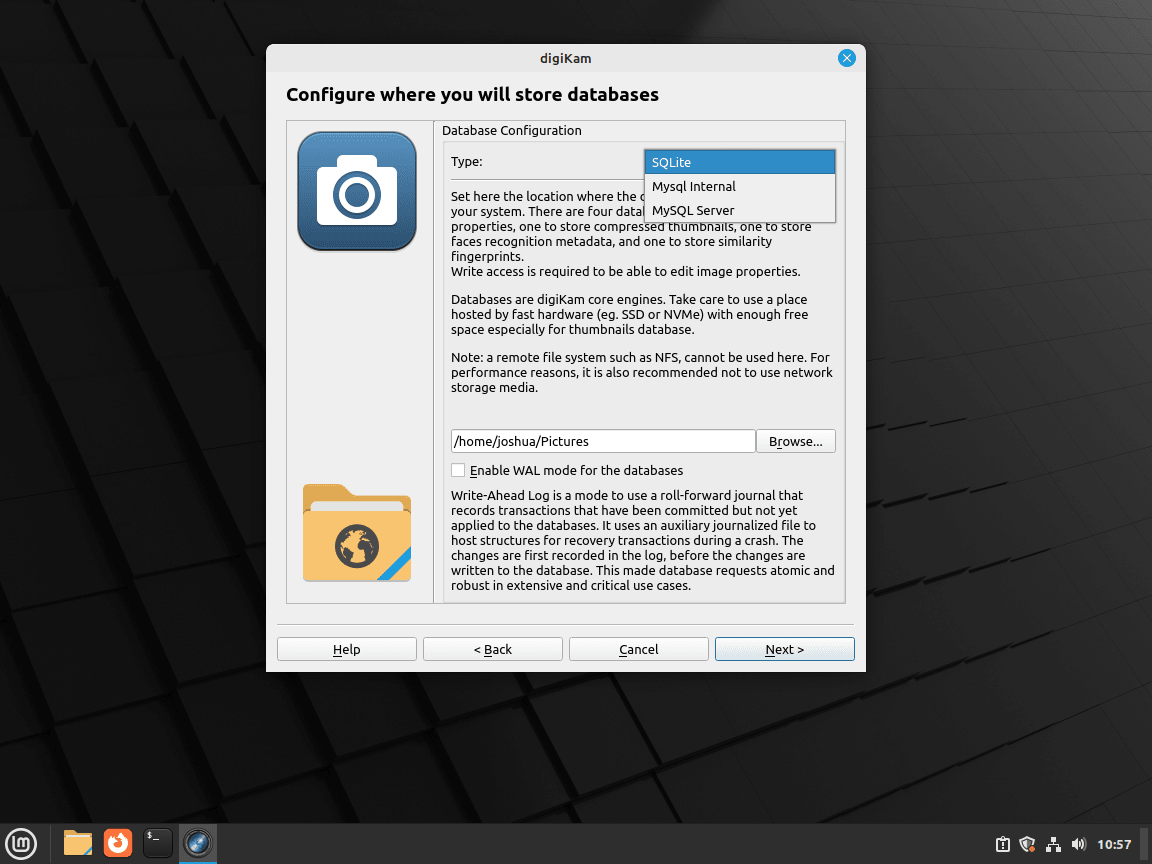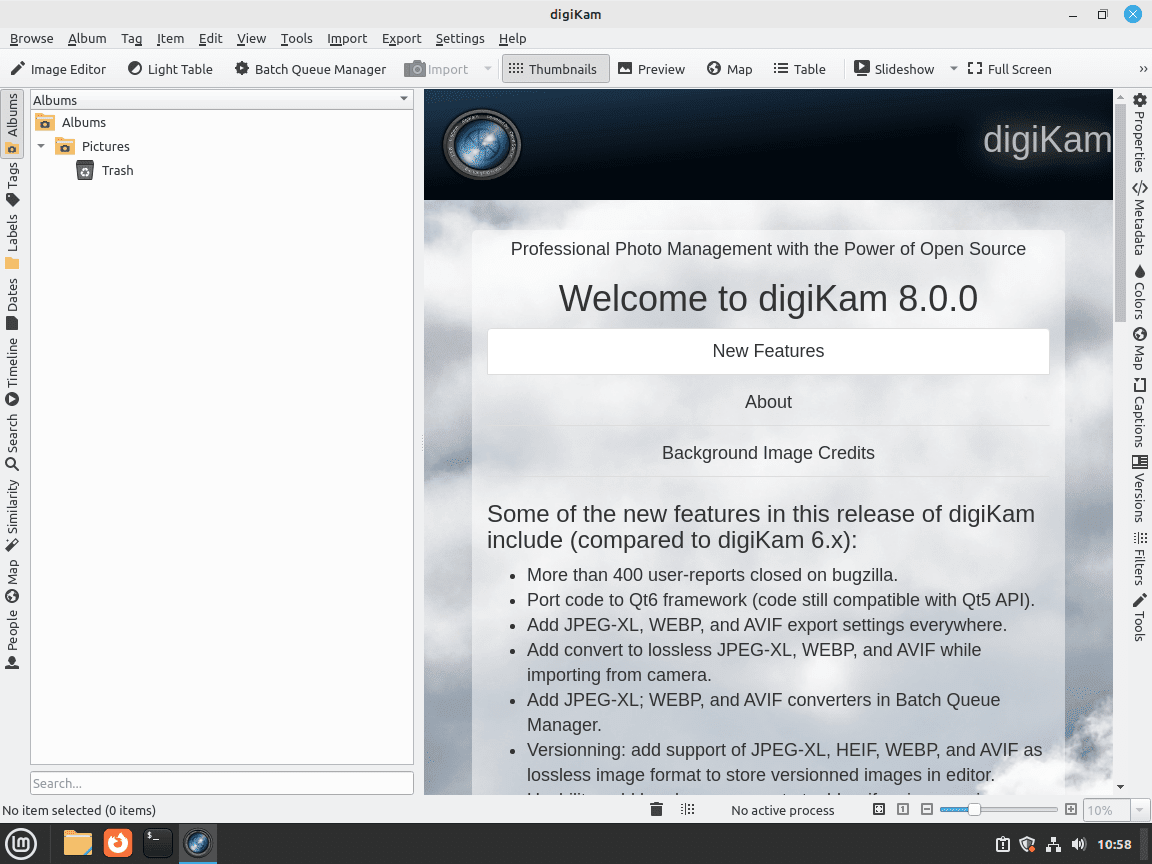digiKam is a powerful open-source photo management application designed for organizing, editing, and sharing digital photos. It supports a wide range of image formats and offers advanced features like metadata management, face recognition, geotagging, and extensive editing tools. With its comprehensive suite of tools, digiKam is ideal for both amateur photographers and professionals looking to manage large photo collections effectively.
On Linux Mint 22 or 21, you have two primary methods to install digiKam. The first method is using the Linux Mint APT repository, which is often the safest and most stable option. For users who want the latest features and updates, you can utilize the Flatpak package manager, which comes pre-installed on Linux Mint, along with the Flathub repository. This guide will walk you through both installation methods.
Method 1: Install digiKam via Linux Mint Repository
Update Linux Mint System Before digiKam Installation
Before installing digiKam, it’s crucial to update your Linux Mint system. Keeping your system updated ensures compatibility and security, minimizing the risk of conflicts during new software installations.
Run the following command in your terminal:
sudo apt update && sudo apt upgradeThis command combines two operations. sudo grants administrative rights necessary for system-wide changes. apt update refreshes your system’s package list, ensuring you have the latest information on available software versions. Following this, apt upgrade updates all installed packages to their newest versions.
Install digiKam via APT Command
Installing digiKam on Linux Mint is straightforward using the APT package manager. The default APT repository, maintained by the official Linux Mint team, provides a stable and secure version of digiKam. However, the version in the default repository might not always be the most recent release.
To install digiKam, execute this command in your terminal:
sudo apt install digikamThis command requests the installation of digiKam. sudo ensures you have the necessary permissions, while apt install digikam tells the package manager to retrieve and install digiKam from the repository.
And that should be it. For an alternative installation method, check out the next section below.
Method 2: Install digiKam via Flatpak and Flathub
Verify if Flatpak is Installed
Before proceeding with digiKam installation, it’s essential to ensure that Flatpak is installed on your Linux Mint system with the following command:
flatpak --versionIf Flatpak is not installed, you can install it by running:
sudo flatpak remote-add --if-not-exists flathub https://flathub.org/repo/flathub.flatpakrepoThis command integrates the Flathub repository into your Flatpak sources. The –if-not-exists flag is a preventive measure, ensuring the repository is added only if it isn’t already present, thus avoiding duplication.
Install digiKam via Flatpak Command
With Flathub enabled you are now ready to install digiKam. Flatpak simplifies the installation process and ensures you get the latest version of digiKam, which the developers directly maintain.
Install digiKam by executing:
flatpak install flathub org.kde.digikam -yThis command instructs Flatpak to install digiKam from Flathub. The application identifier org.kde.digikam specifies the exact software to install. The -y option automatically agrees to the installation prompts, facilitating a smoother and faster installation process.
Launching digiKam
CLI Commands to Launch digiKam
After installing digiKam, you can quickly launch it using the terminal, a versatile tool for managing your Linux system. This method is incredibly convenient if you have a terminal window already open.
To start digiKam, enter the following command in the terminal:
digikamThis command instructs your system to execute digiKam. It’s a straightforward and efficient way to access the application, especially for those who frequently use the terminal.
If you installed digiKam through Flatpak, the launch command differs. For Flatpak installations, use:
flatpak run org.kde.digikamThis variant tells Flatpak to run digiKam, with org.kde.digikam being the unique identifier for the digiKam application in the Flatpak package management system.
GUI Method to Launch digiKam
DigiKam can also be launched from the desktop environment for users who prefer a graphical approach. This method is user-friendly and doesn’t require command-line knowledge.
To start digiKam using the GUI:
- Open the application menu on your taskbar.
- Navigate to the ‘Graphics’ category.
- Find and click on digiKam to launch it.




Managing digiKam
Update digiKam
Regularly updating applications like digiKam is vital for security, functionality, and accessing new features. While Linux Mint usually alerts users about available updates, manually checking is a reliable practice.
APT Method to Update digiKam
For digiKam installations via APT, updating is straightforward. Open the terminal and execute:
sudo apt updateThis command refreshes your package list, identifying any available updates for installed applications, including digiKam. It ensures your software stays current with the latest enhancements and security patches.
Flatpak Method to Update digiKam
For those who installed digiKam using Flatpak, updates are handled using a different command. In your terminal, run:
flatpak updateThis command checks for and applies updates to all your Flatpak applications, ensuring they remain up-to-date.
Remove digiKam
If digiKam is no longer needed, it can be removed based on your installation method.
APT Method to Remove digiKam
To uninstall digiKam installed through APT, use the terminal:
sudo apt remove digikamThis command directs APT to remove digiKam from your system, freeing up space and resources.
Flatpak Method to Remove digiKam
For digiKam installations via Flatpak, removal requires a specific command:
flatpak remove --delete-data org.kde.digikam -yThis command not only removes digiKam but also deletes its data.
Conclusion
With digiKam successfully installed on your Linux Mint system, you can begin managing and editing your photo collections with ease. Whether you choose the stable and reliable APT repository or opt for the latest build via Flatpak, both methods ensure you have access to digiKam’s extensive features. Regularly updating your installation will help you take full advantage of digiKam’s powerful tools for organizing and editing your photos. Enjoy the versatility and efficiency that digiKam brings to your photography workflow.

